
A much cheaper alignment method performing as well as DPO
Originally appeared here:
ORPO: Preference Optimization without the Supervised Fine-tuning (SFT) Step


A much cheaper alignment method performing as well as DPO
Originally appeared here:
ORPO: Preference Optimization without the Supervised Fine-tuning (SFT) Step
Although overwriting objects is a typical Python coding technique, it can lead to unexpected effects. You need to know how to use it.
Originally appeared here:
Overwriting in Python: Tricky. Dangerous. Powerful
Go Here to Read this Fast! Overwriting in Python: Tricky. Dangerous. Powerful

Deep learning frameworks are extremely transitory. If you compare the deep learning frameworks people use today with what it was eight years ago, you will find the landscape is completely different. There were Theano, Caffe2, and MXNet, which all went obsolete. Today’s most popular frameworks, like TensorFlow and PyTorch, were just released to the public.
Through all these years, Keras has survived as a high-level user-facing library supporting different backends, including TensorFlow, PyTorch, and JAX. As a contributor to Keras, I learned how much the team cares about user experience for the software and how they ensured a good user experience by following a few simple yet powerful principles in their design process.
In this article, I will share the 3 most important software design principles I learned by contributing to the Keras through the past few years, which may be generalizable to all types of software and help you make an impact in the open-source community with yours.
Before we dive into the main content, let’s quickly discuss why user experience is so important. We can learn this through the PyTorch vs. TensorFlow case.
They were developed by two tech giants, Meta and Google, and have quite different cultural strengths. Meta is good at product, while Google is good at engineering. As a result, Google’s frameworks like TensorFlow and JAX are the fastest to run and technically superior to PyTorch, as they support sparse tensors and distributed training well. However, PyTorch still took away half of the market share from TensorFlow because it prioritizes user experience over other aspects of the software.
Better user experience wins for the research scientists who build the models and propagate them to the engineers, who take models from them since they don’t always want to convert the models they receive from the research scientists to another framework. They will build new software around PyTorch to smooth their workflow, which will establish a software ecosystem around PyTorch.
TensorFlow also made a few blunders that caused its users to lose. TensorFlow’s general user experience is good. However, its installation guide for GPU support was broken for years before it was fixed in 2022. TensorFlow 2 broke the backward compatibility, which cost its users millions of dollars to migrate.
So, the lesson we learned here is that despite technical superiority, user experience decides which software the open-source users would choose.
All the deep learning frameworks—TensorFlow, PyTorch, and JAX—invest heavily in user experience. Good evidence is that they all have a relatively high Python percentage in their codebases.
All the core logic of deep learning frameworks, including tensor operations, automatic differentiation, compilation, and distribution are implemented in C++. Why would they want to expose a set of Python APIs to the users? It is just because the users love Python and they want to polish their user experience.
Imagine how much engineering effort it requires to make your deep learning framework a little bit faster than others. A lot.
However, for a better user experience, as long as you follow a certain design process and some principles, you can achieve it. For attracting more users, your user experience is as important as the computing efficiency of your framework. So, investing in user experience is of high return on investment (ROI).
I will share the three important software design principles I learned by contributing to Keras, each with good and bad code examples from different frameworks.
When we think of designing the APIs of a piece of software, you may look like this.
class Model:
def __call__(self, input):
"""The forward call of the model.
Args:
input: A tensor. The input to the model.
"""
pass
Define the class and add the documentation. Now, we know all the class names, method names, and arguments. However, this would not help us understand much about the user experience.
What we should do is something like this.
input = keras.Input(shape=(10,))
x = layers.Dense(32, activation='relu')(input)
output = layers.Dense(10, activation='softmax')(x)
model = keras.models.Model(inputs=input, outputs=output)
model.compile(
optimizer='adam', loss='categorical_crossentropy'
)
We want to write out the entire user workflow of using the software. Ideally, it should be a tutorial on how to use the software. It provides much more information about the user experience. It may help us spot many more UX problems during the design phase compared with just writing out the class and methods.
Let’s look at another example. This is how I discovered a user experience problem by following this principle when implementing KerasTuner.
When using KerasTuner, users can use this RandomSearch class to select the best model. We have the metrics, and objectives in the arguments. By default, objective equals validation loss. So, it helps us find the model with the smallest validation loss.
class RandomSearch:
def __init__(self, ..., metrics, objective="val_loss", ...):
"""The initializer.
Args:
metrics: A list of Keras metrics.
objective: String or a custom metric function. The
name of the metirc we want to minimize.
"""
pass
Again, it doesn’t provide much information about the user experience. So, everything looks OK for now.
However, if we write an end-to-end workflow like the following. It exposes many more problems. The user is trying to define a custom metric function named custom_metric. The objective is not so straightforward to use anymore. What should we pass to the objective argument now?
tuner = RandomSearch(
...,
metrics=[custom_metric],
objective="val_???",
)
It should be just “val_custom_metric”. Just use the prefix of “val_” and the name of the metric function. It is not intuitive enough. We want to make it better instead of forcing the user to learn this. We easily spotted a user experience problem by writing this workflow.
If you wrote the design more comprehensively by including the implementation of the custom_metric function, you will find you even need to learn how to write a Keras custom metric. You have to follow the function signature to make it work, as shown in the following code snippet.
def custom_metric(y_true, y_pred):
squared_diff = ops.square(y_true - y_pred)
return ops.mean(squared_diff, axis=-1)
After discovering this problem. We specially designed a better workflow for custom metrics. You only need to override HyperModel.fit() to compute your custom metric and return it. No strings to name the objective. No function signature to follow. Just a return value. The user experience is much better right now.
class MyHyperModel(HyperModel):
def fit(self, trial, model, validation_data):
x_val, y_true = validation_data
y_pred = model(x_val)
return custom_metric(y_true, y_pred)
tuner = RandomSearch(MyHyperModel(), max_trials=20)
One more thing to remember is we should always start from the user experience. The designed workflows backpropagate to the implementation.
Do not force the user to learn anything unless it is really necessary. Let’s see some good examples.
The Keras modeling API is a good example shown in the following code snippet. The model builders already have these concepts in mind, for example, a model is a stack of layers. It needs a loss function. We can fit it with data or make it predict on data.
model = keras.Sequential([
layers.Dense(10, activation="relu"),
layers.Dense(num_classes, activation="softmax"),
])
model.compile(loss='categorical_crossentropy')
model.fit(...)
model.predict(...)
So basically, no new concepts were learned to use Keras.
Another good example is the PyTorch modeling. The code is executed just like Python code. All tensors are just real tensors with real values. You can depend on the value of a tensor to decide your path with plain Python code.
class MyModel(nn.Module):
def forward(self, x):
if x.sum() > 0:
return self.path_a(x)
return self.path_b(x)
You can also do this with Keras with TensorFlow or JAX backend but needs to be written differently. All the if conditions need to be written with this ops.cond function as shown in the following code snippet.
class MyModel(keras.Model):
def call(self, inputs):
return ops.cond(
ops.sum(inputs) > 0,
lambda : self.path_a(inputs),
lambda : self.path_b(inputs),
)
This is teaching the user to learn a new op instead of using the if-else clause they are familiar with, which is bad. In compensation, it brings significant improvement in training speed.
Here is the catch of the flexibility of PyTorch. If you ever needed to optimize the memory and speed of your model, you would have to do it by yourself using the following APIs and new concepts to do so, including the inplace arguments for the ops, the parallel op APIs, and explicit device placement. It introduces a rather high learning curve for the users.
torch.relu(x, inplace=True)
x = torch._foreach_add(x, y)
torch._foreach_add_(x, y)
x = x.cuda()
Some other good examples are keras.ops, tensorflow.numpy, jax.numpy. They are just a reimplementation of the numpy API. When introducing some cognitive load, just reuse what people already know. Every framework has to provide some low-level ops in these frameworks. Instead of letting people learn a new set of APIs, which may have a hundred functions, they just use the most popular existing API for it. The numpy APIs are well-documented and have tons of Stack Overflow questions and answers related to it.
The worst thing you can do with user experience is to trick the users. Trick the user to believe your API is something they are familiar with but it is not. I will give two examples. One is on PyTorch. The other one is on TensorFlow.
What should we pass as the pad argument in F.pad() function if you want to pad the input tensor of the shape (100, 3, 32, 32) to (100, 3, 1+32+1, 2+32+2) or (100, 3, 34, 36)?
import torch.nn.functional as F
# pad the 32x32 images to (1+32+1)x(2+32+2)
# (100, 3, 32, 32) to (100, 3, 34, 36)
out = F.pad(
torch.empty(100, 3, 32, 32),
pad=???,
)
My first intuition is that it should be ((0, 0), (0, 0), (1, 1), (2, 2)), where each sub-tuple corresponds to one of the 4 dimensions, and the two numbers are the padding size before and after the existing values. My guess is originated from the numpy API.
However, the correct answer is (2, 2, 1, 1). There is no sub-tuple, but one plain tuple. Moreover, the dimensions are reversed. The last dimension goes the first.
The following is a bad example from TensorFlow. Can you guess what is the output of the following code snippet?
value = True
@tf.function
def get_value():
return value
value = False
print(get_value())
Without the tf.function decorator, the output should be False, which is pretty simple. However, with the decorator, the output is True. This is because TensorFlow compiles the function and any Python variable is compiled into a new constant. Changing the old variable’s value would not affect the created constant.
It tricks the user into believing it is the Python code they are familiar with, but actually, it is not.
No one likes to read long documentation if they can figure it out just by running some example code and tweaking it by themselves. So, we try to make the user workflow of the software follow the same logic.
Here is a good example shown in the following code snippet. In PyTorch, all methods with the underscore are inplace ops, while the ones without are not. From an interactive perspective, these are good, because they are easy to follow, and the users do not need to check the docs whenever they want the inplace version of a method. However, of course, they introduced some cognitive load. The users need to know what does inplace means and when to use them.
x = x.add(y)
x.add_(y)
x = x.mul(y)
x.mul_(y)
Another good example is the Keras layers. They strictly follow the same naming convention as shown in the following code snippet. With a clear naming convention, the users can easily remember the layer names without checking the documentation.
from keras import layers
layers.MaxPooling2D()
layers.GlobalMaxPooling1D()
layers.GlobalAveragePooling3D()
Another important part of the interaction between the user and the software is the error message. You cannot expect the user to write everything correctly the very first time. We should always do the necessary checks in the code and try to print helpful error messages.
Let’s see the following two examples shown in the code snippet. The first one has not much information. It just says tensor shape mismatch. The
second one contains much more useful information for the user to find the bug. It not only tells you the error is because of tensor shape mismatch, but it also shows what is the expected shape and what is the wrong shape it received. If you did not mean to pass that shape, you have a better idea
of the bug now.
# Bad example:
raise ValueError("Tensor shape mismatch.")
# Good example:
raise ValueError(
"Tensor shape mismatch. "
"Expected: (batch, num_features). "
f"Received: {x.shape}"
)
The best error message would be directly pointing the user to the fix. The following code snippet shows a general Python error message. It guessed what was wrong with the code and directly pointed the user to the fix.
import math
math.sqr(4)
"AttributeError: module 'math' has no attribute 'sqr'. Did you mean: 'sqrt'?"
So far we have introduced the three most valuable software design principles I have learned when contributing to the deep learning frameworks. First, write end-to-end workflows to discover more user experience problems. Second, reduce cognitive load and do not teach the user anything unless necessary. Third, follow the same logic in your API design and throw meaningful error messages so that the users can learn your software by interacting with it instead of constantly checking the documentation.
However, there are many more principles to follow if you want to make your software even better. You can refer to the Keras API design guidelines as a complete API design guide.
Design an Easy-to-Use Deep Learning Framework was originally published in Towards Data Science on Medium, where people are continuing the conversation by highlighting and responding to this story.
Originally appeared here:
Design an Easy-to-Use Deep Learning Framework
Go Here to Read this Fast! Design an Easy-to-Use Deep Learning Framework



I suppose most of us have heard the statement “correlation doesn’t imply causation” multiple times. It often becomes a problem for analysts since we frequently can see only correlations but still want to make causal conclusions.
Let’s discuss a couple of examples to understand the difference better. I would like to start with a case from everyday life rather than the digital world.
In 1975, a vast population study was launched in Denmark. It’s called the Copenhagen City Heart Study (CCHS). Researchers gathered information about 20K men and women and have been monitoring these people for decades. The initial goal of this research was to find ways to prevent cardiovascular diseases and strokes. One of the conclusions from this study is that people who reported regularly playing tennis have 9.7 years higher life expectancy.
Let’s think about how we could interpret this information. Does it mean that if a person starts playing tennis weekly today, they will increase their life expectancy by ten years? Unfortunately, not exactly. Since it’s an observational study, we should be cautious about making causal inferences. There might be some other effects. For example, tennis players are likely to be wealthier, and we know that higher wealth correlates with greater longevity. Or there could be a correlation that people who regularly do sports also care more about their health and, because of it, do all checkups regularly. So, observational research might overestimate the effect of tennis on longevity since it doesn’t control other factors.
Let’s move on to the examples closer to product analytics and our day-to-day job. The number of Customer Support contacts for a client will likely be positively correlated with the probability of churn. If customers had to contact our support ten times, they would likely be annoyed and stop using our product, while customers who never had problems and are happy with the service might never reach out with any questions.
Does it mean that if we reduce the number of CS contacts, we will increase customer retention? I’m ready to bet that if we hide contact info and significantly reduce the number of CS contacts, we won’t be able to decrease churn because the actual root cause of churn is not CS contact but customers’ dissatisfaction with the product, which leads to both customers contacting us and stopping using our product.
I hope that with these examples, you can gain some intuition about the correlation vs. causation problem.
In this article, I would like to share approaches for driving causal conclusions from the data. Surprisingly, we will be able to use the most basic tool — just a linear regression.
If we use the same linear regression for causal inference, you might wonder, what is the difference between our usual approach and causal analytics? That’s a good question. Let’s start our causal journey by understanding the differences between approaches.
Predictive analytics helps to make forecasts and answer questions like “How many customers will we have in a year if nothing changes?” or “What is the probability for this customer to make a purchase within the next seven days?”.
Causal analytics tries to understand the root causes of the process. It might help you to answer “what if” questions like “How many customers will churn if we increase our subscription fee?” or “How many customers would have signed up for our subscription if we didn’t launch this Saint Valentine’s promo?”.
Causal questions seem way more complicated than just predictive ones. However, these two approaches often leverage the same tools, such as linear or logistic regressions. Even though tools are the same, they have absolutely different goals:
Let’s look at a simple example. Suppose we would like to forecast the number of active customers.
Now, it’s time to dive into causal theory and learn basic terms.
Let’s consider the following example for our discussion. Imagine you sent a discount coupon to loyal customers of your product, and now you want to understand how it affected their value (money spent on the product) and retention.
One of the most basic causal terms is treatment. It sounds like something related to the medicine, but actually, it’s just an intervention. In our case, it’s a discount. We usually define treatment at the unit level (in our case, customer) in the following way.

The other crucial term is outcome Y, our variable of interest. In our example, it’s the customer’s value.
The fundamental problem of causal inference is that we can’t observe both outcomes for the same customers. So, if a customer received the discount, we will never know what value or retention he would have had without a coupon. It makes causal inference tricky.
That’s why we need to introduce another concept — potential outcomes. The outcome that happened is usually called factual, and the one that didn’t is counterfactual. We will use the following notation for it.

The main goal of causal analysis is to measure the relationship between treatment and outcome. We can use the following metrics to quantify it:
They are both equal to expected values of the differences between potential outcomes either for all units (customers in our case) or only for treated ones.

That’s an actual causal effect, and unfortunately, we won’t be able to calculate it. But cheer up; we can still get some estimations. We can observe the difference between values for treated and not treated customers (correlation effect). Let’s try to interpret this value.

Using a couple of simple mathematical transformations (i.e. adding and subtracting the same value), we’ve concluded that the average in values between treated and not treated customers equals the sum of ATT (average treatment effect on treated) and bias term. The bias equals the difference between control and treatment groups without a treatment.
If we return to our case, the bias will be equal to the difference between expected customer value for the treatment group if they haven’t received discount (counterfactual outcome) and the control group (factual outcome).
In our example, the average value from customers who received a discount will likely be much higher than for those who didn’t. Could we attribute all this effect to our treatment (discount coupon)? Unfortunately not. Since we sent discount to loyal customers who are already spending a lot of money in our product, they would likely have higher value than control group even without a treatment. So, there’s a bias, and we can’t say that the difference in value between two segments equals ATT.
Let’s think about how to overcome this obstacle. We can do an A/B test: randomly split our loyal customers into two groups and send discount coupons only to half of them. Then, we can estimate the discount’s effect as the average difference between these two groups since we’ve eliminated bias (without treatment, there’s no difference between these groups except for discount).
We’ve covered the basic theory of causal inference and have learned the most crucial concept of bias. So, we are ready to move on to practice. We will start by analysing the A/B test results.
Randomised controlled trial (RTC), often called the A/B test, is a powerful tool for getting causal conclusions from data. This approach assumes that we are assigning treatment randomly, and it helps us eliminate bias (since groups are equal without treatment).
To practice solving such tasks, we will look at the example based on synthetic data. Suppose we’ve built an LLM-based tool that helps customer support agents answer questions more quickly. To measure the effect, we introduced this tool to half of the agents, and we would like to measure how our treatment (LLM-based tool) affects the outcome (time the agent spends answering a customer’s question).
Let’s have a quick look at the data we have.

Here are the description of the parameters we logged:
As usual, let’s start with a high-level overview of the data. We have quite a lot of data points, so we will likely be able to get statistically significant results. Also, we can see way lower average response times for the treatment group, so we can hope that the LLM tool really helps.

I also usually look at the actual distributions since average statistics might be misleading. In this case, we can see two unimodal distributions without distinctive outliers.
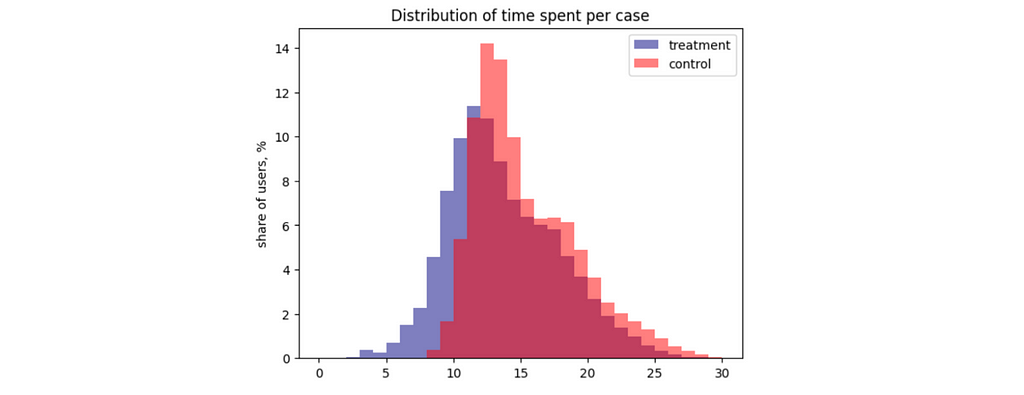
The classic approach to analysing A/B tests is to use statistical formulas. Using the scipy package, we can calculate the confidence interval for the difference between the two means.
# defining samples
control_values = df[df.treatment == 0].time_spent_mins.values
exp_values = df[df.treatment == 1].time_spent_mins.values
# calculating p-values
from scipy.stats import ttest_ind
ttest_ind(exp_values, control_values)
# Output: TtestResult(statistic=-70.2769283935386, pvalue=0.0, df=89742.0)
We got a p-value below 1%. So, we can reject the null hypothesis and conclude that there’s a difference in average time spent per case in the control and test groups. To understand the effect size, we can also calculate the confidence interval.
from scipy import stats
import numpy as np
# Calculate sample statistics
mean1, mean2 = np.mean(exp_values), np.mean(control_values)
std1, std2 = np.std(exp_values, ddof=1), np.std(control_values, ddof=1)
n1, n2 = len(exp_values), len(control_values)
pooled_std = np.sqrt(((n1 - 1) * std1**2 + (n2 - 1) * std2**2) / (n1 + n2 - 2))
degrees_of_freedom = n1 + n2 - 2
confidence_level = 0.95
# Calculate margin of error
margin_of_error = stats.t.ppf((1 + confidence_level) / 2, degrees_of_freedom) * pooled_std * np.sqrt(1 / n1 + 1 / n2)
# Calculate confidence interval
mean_difference = mean1 - mean2
conf_interval = (mean_difference - margin_of_error,
mean_difference + margin_of_error)
print("Confidence Interval:", list(map(lambda x: round(x, 3), conf_interval)))
# Output: Confidence Interval: [-1.918, -1.814]
As expected since p-value is below 5%, our confidence interval doesn’t include 0.
The traditional approach works. However, we can get the same results with linear regression, which will also allow us to do more advanced analysis later. So, let’s discuss this method.
As we already discussed, observing both potential outcomes (with and without treatment) for the same object is impossible. Since we won’t be able to estimate the impact on each object individually, we need a model. Let’s assume the constant treatment effect.

Then, we can write down the relation between outcome (time spent on request) and treatment in the following way, where

It’s a linear equation, and we can get the estimation of the impact variable using linear regression. We will use OLS (Ordinary Least Squares) function from statsmodels package.
import statsmodels.formula.api as smf
model = smf.ols('time_spent_mins ~ treatment', data=df).fit()
model.summary().tables[1]
In the result, we got all the needed info: estimation of the effect (coefficient for the treatment variable), its p-value and confidence interval.

Since the p-value is negligible (definitely below 1%), we can consider the effect significant and say that our LLM-based tool helps to reduce the time spent on a case by 1.866 minutes with a 95% confidence interval (1.814, 1.918). You can notice that we got exactly the same result as with statistical formulas before.
As promised, we can make a more complex analysis with linear regression and take into account more factors, so let’s do it. In our initial approach, we used only one regressor — treatment flag. However, we can add more variables (for example, complexity).

In this case, the impact will show estimation after accounting for all the effects of other variables in the model (in our case — task complexity). Let’s estimate it. Adding more variables into the regression model is straightforward — we just need to add another component to the equation.
import statsmodels.formula.api as smf
model = smf.ols('time_spent_mins ~ treatment + complexity', data=df).fit()
model.summary().tables[1]
Now, we see a bit higher estimation of the effect — 1.91 vs 1.87 minutes. Also, the error has decreased (0.015 vs 0.027), and the confidence interval has narrowed.

You can also notice that since complexity is a categorical variable, it was automatically converted into a bunch of dummy variables. So, we got estimations of -9.8 minutes for low-complexity tasks and -4.7 minutes for medium ones.
Let’s try to understand why we got a more confident result after adding complexity. Time spent on a customer case significantly depends on the complexity of the tasks. So, complexity is responsible for a significant amount of our variable’s variability.

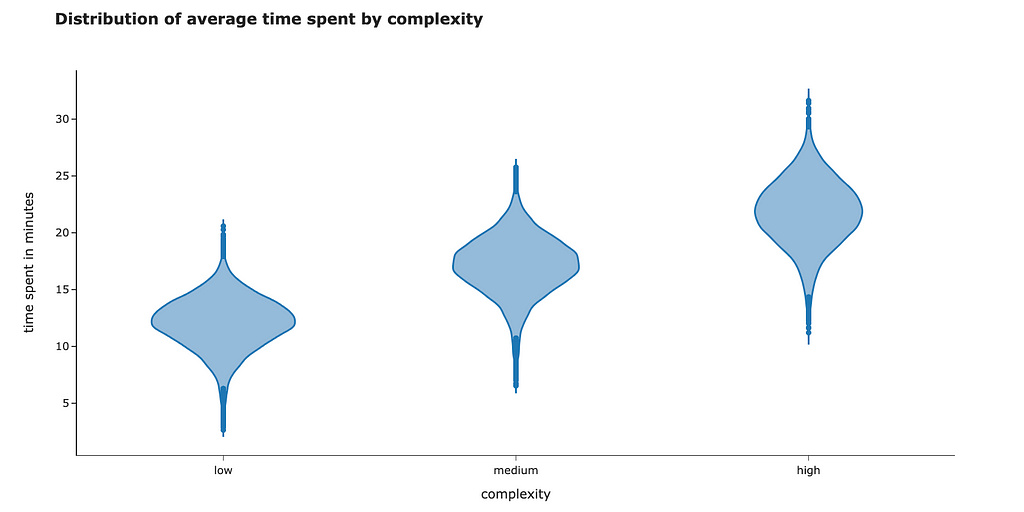
As I mentioned before, the coefficient for treatment estimates the impact after accounting for all the other factors in the equation. When we added complexity to our linear regression, it reduced the variance of residuals, and that’s why we got a narrower confidence interval for time.
Let’s double-check that complexity explains a significant proportion of variance. We can see a considerable decrease: time spent has a variance equal to 16.6, but when we account for complexity, it reduces to just 5.9.
time_model = smf.ols('time_spent_mins ~ complexity', data=df).fit()
print('Initial variance: %.2f' % (df.time_spent_mins.var()))
print('Residual variance after accounting for complexity: %.2f'
% (time_model.resid.var()))
# Output:
# Initial variance: 16.63
# Residual variance after accounting for complexity: 5.94
So, we can see that adding a factor that can predict the outcome variable to a linear regression can improve your effect size estimations. Also, it’s worth noting that the variable is not correlated with treatment assignment (the tasks of each complexity have equal chances to be in the control or test group).
Traditionally, causal graphs are used to show the relationships between the variables. Let’s draw such a graph to represent our current situation.
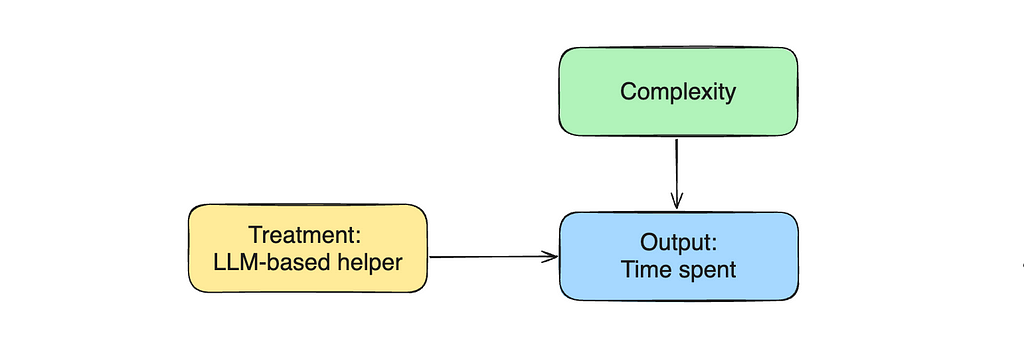
So far, we’ve looked only at linear relationships, but sometimes, it’s not enough to model our situation.
Let’s look at the data on LLM training that agents from the experiment group were supposed to pass. Only half of them have passed the LLM training and learned how to use the new tool effectively.

We can see a significant difference in average time spent for the treatment group who passed training vs. those who didn’t.
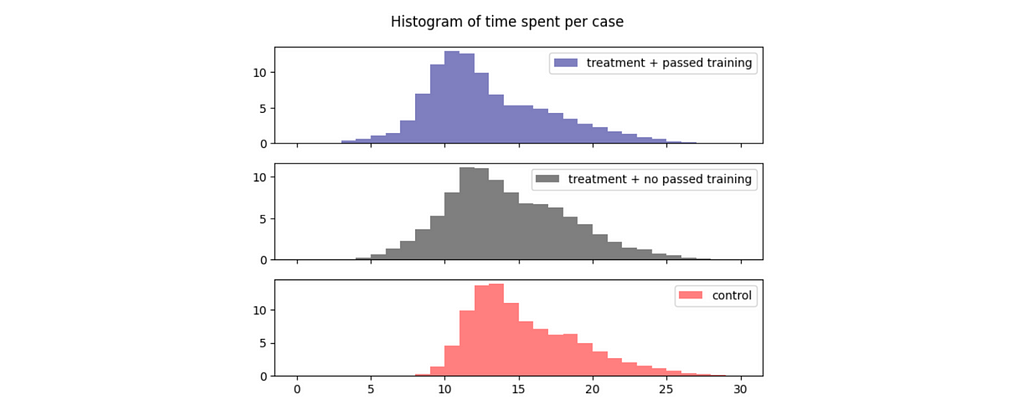
So, we should expect different impacts from treatment for these two groups. We can use non-linearity to express such relationships in formulas and add treatment * passed_training component to our equation.
model = smf.ols('time_spent_mins ~ treatment * passed_training + complexity',
data=df).fit()
model.summary().tables[1]
The treatment and passed_training factors will also be automatically added to the regression. So, we will be optimising the following formula.

We got the following results from the linear regression.

No statistically significant effect is associated with passed training since the p-value is above 5%, while other coefficients differ from zero.
Let’s put down all the different scenarios and estimate the effects using the coefficients we got from the linear regression.

So, we’ve got new treatment estimations: 2.5 minutes improvement per case for the agents who have passed the training and 1.3 minutes — for those who didn’t.
Before jumping to conclusions, it’s worth double-checking some assumptions we made — for example, random assignment. We’ve discussed that we launched the experiment in some CS centres. Let’s check whether agents in the different centres are similar so that our control and test groups are non-biased.
We know that agents differ by experience, which might significantly affect their performance. Our day-to-day intuition tells us that more experienced agents will spend less time on tasks. We can see in the data that it is actually like this.
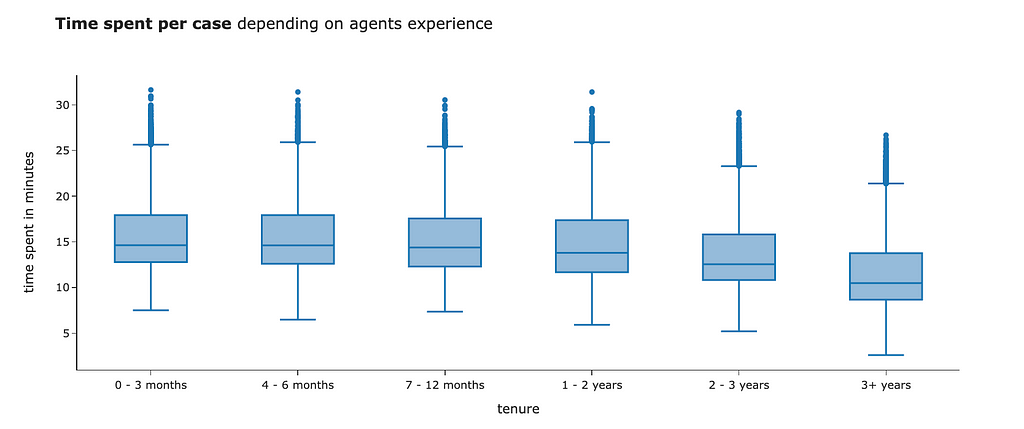
Let’s see whether our experiment and control have the same level of agents’ experience. The easiest way to do it is to look at distributions.
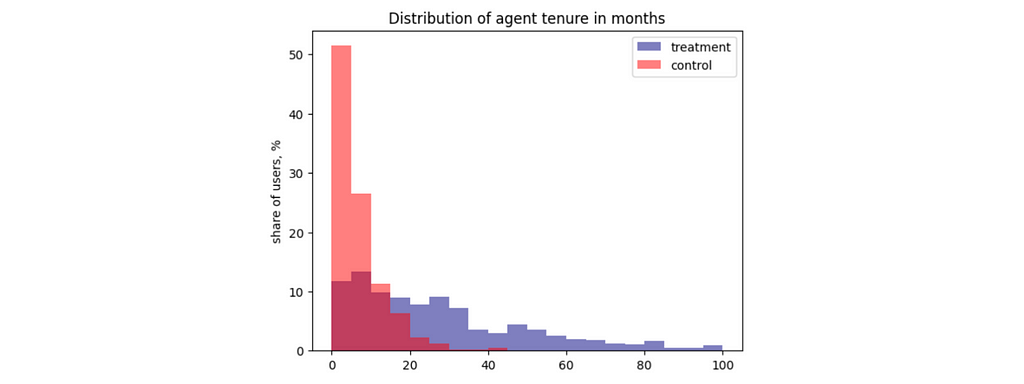
Apparently, agents in the treatment group have much more experience than the ones in the control group. Overall, it makes sense that the product team decided to launch the experiment, starting with the more trained agents. However, it breaks our assumption about random assignment. Since the control and test groups are different even without treatment, we are overestimating the effect of our LLM tool on the agents’ performance.
Let’s return to our causal graph. The agent’s experience affects both treatment assignment and output variable (time spent). Such variables are called confounders.

Don’t worry. We can solve this issue effortlessly — we just need to include confounders in our equation to control for it. When we add it to the linear regression, we start to estimate the treatment effect with fixed experience, eliminating the bias. Let’s try to do it.
model = smf.ols('time_spent_mins ~ treatment * passed_training + complexity + tenure', data=df).fit()
model.summary().tables[1]

With added tenure, we got the following results:
We are working with synthetic data so we can easily compare our estimations with actual effects. The LLM tool reduces the time spent per task by 1 minute if the agent has passed the training, so our estimations are pretty accurate.
Machine learning tasks are often straightforward: you gather data with all possible features you can get, try to fit some models, compare their performance and pick the best one. Contrarily, causal inference requires some art and a deep understanding of the process you’re working with. One of the essential questions is what features are worth including in regression and which ones will spoil your results.
Till now, all the additional variables we’ve added to the linear regression have been improving the accuracy. So, you might think adding all your features to regression will be the best strategy. Unfortunately, it’s not that easy for causal inference. In this section, we will look at a couple of cases when additional variables decrease the accuracy of our estimations.
For example, we have a CS centre in data. We’ve assigned treatment based on the CS centre, so including it in the regression might sound reasonable. Let’s try.
model = smf.ols('time_spent_mins ~ treatment + complexity + tenure + cs_center',
data=df[df.treatment == df.passed_training]).fit()
model.summary().tables[1]
For simplicity, I’ve removed non-linearity from our dataset and equation, filtering out cases where the agents from the treatment groups didn’t pass the LLM training.

If we include the CS centre in linear regression, we will get a ridiculously high estimation of the effect (around billions) without statistical significance. So, this variable is rather harmful than helpful.
Let’s update a causal chart and try to understand why it doesn’t work. CS centre is a predictor for our treatment but has no relationship with the output variable (so it’s not a confounder). Adding a treatment predictor leads to multicollinearity (like in our case) or reduces the treatment variance (it’s challenging to estimate the effect of treatment on the output variable since treatment doesn’t change much). So, it’s a bad practice to add such variables to the equation.
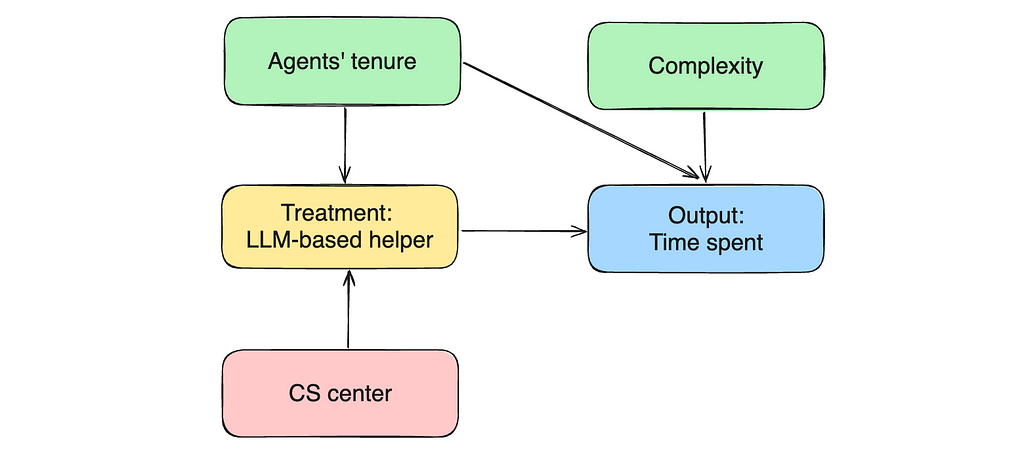
Let’s move on to another example. We have a within_sla variable showing whether the agents finished the task within 15 minutes. Can this variable improve the quality of our effect estimations? Let’s see.
model = smf.ols('time_spent_mins ~ treatment + complexity + tenure + within_sla',
data=df[df.treatment == df.passed_training]).fit()
model.summary().tables[1]

The new effect estimation is way lower: 0.8 vs 1.1 minutes. So, it poses a question: which one is more accurate? We’ve added more parameters to this model, so it’s more complex. Should it give more precise results, then? Unfortunately, it’s not always like that. Let’s dig deeper into it.
In this case, within_sla flag shows whether the agent solved the problem within 15 minutes or the question took more time. So, if we return to our causal chart, within_sla flag is an outcome of our output variable (time spent on the task).
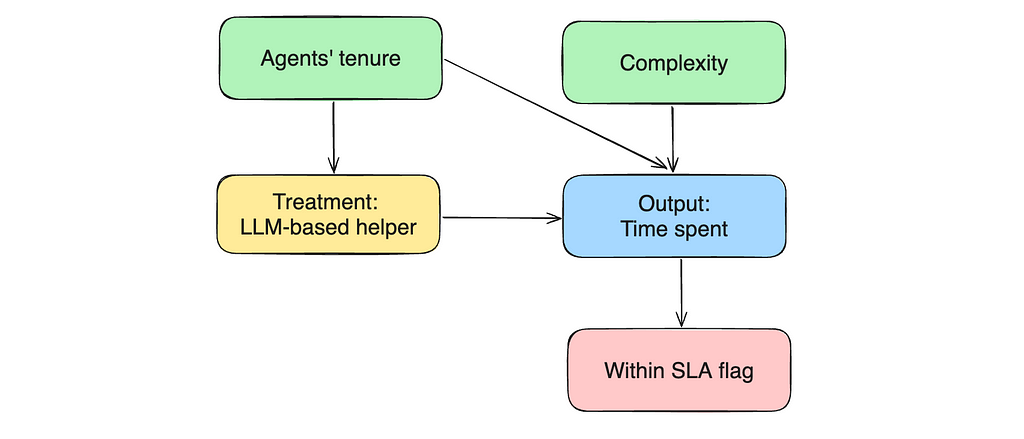
When we add the within_slag flag into regression and control for it, we are starting to estimate the effect of treatment with a fixed value of within_sla. So, we will have two cases: within_sla = 1 and within_sla = 0. Let’s look at the bias for each of them.

In both cases, bias is not equal to 0, which means our estimation is biased. At first glance, it might look a bit counterintuitive. Let me explain the logic behind it a bit.
It’s an example of selection bias — a case when we control for a variable on the path from treatment to output variable or outcome of the output variable. Controlling for such variables in a linear regression also leads to biased estimations, so don’t do it.
In some cases, you might not have granular data. In our example, we might not know the time spent on each task individually, but know the averages. It’s easier to track aggregated numbers for agents. For example, “within two hours, an agent closed 15 medium tasks”. We can aggregate our raw data to get such statistics.
agents_df = df.groupby(['agent_id', 'treatment', 'complexity', 'tenure',
'passed_training'], as_index = False).aggregate(
{'case_id': 'nunique', 'time_spent_mins': 'mean'}
)
It’s not a problem for linear regression to deal with agent-level data. We just need to specify weights for each agent (equal to the number of cases).
model = smf.ols('time_spent_mins ~ treatment + complexity + tenure',
data = agents_df[agents_df.treatment == agents_df.passed_training],
weights = agents_df[agents_df.treatment == agents_df.passed_training]['case_id'])
.fit()
model.summary().tables[1]
With aggregated data, we have roughly the same results for the effect of treatment. So, there’s no problem if you have only average numbers.

We’ve looked at the A/B test examples for causal inference in detail. However, in many cases, we can’t conduct a proper randomised trial. Here are some examples:
In such cases, you have to use just observations to make conclusions. Let’s see how our approach works in such a case. We will use the Student Performance data set from the UC Irvine Machine Learning Repository.
Let’s use this real-life data to investigate how willingness to take higher education affects the math class’s final score. We will start with a trivial model and a causal chart.

df = pd.read_csv('student-mat.csv', sep = ';')
model = smf.ols('G3 ~ higher', data=df).fit()
model.summary().tables[1]
We can see that willingness to continue education statistically significantly increases the final grade for the course by 3.8 points.

However, there might be some confounders that we have to control for. For example, parents’ education can affect both treatments (children are more likely to plan to take higher education if their parents have it) and outcomes (educated parents are more likely to help their children so that they have higher grades). Let’s add the mother and father’s education level to the model.

model = smf.ols('G3 ~ higher + Medu + Fedu', data=df).fit()
model.summary().tables[1]
We can see a statistically significant effect from the mother’s education. We likely improved the accuracy of our estimation.

However, we should treat any causal conclusions based on observational data with a pinch of salt. We can’t be sure that we’ve taken into account all confounders and that the estimation we’ve got is entirely unbiased.
Also, it might be tricky to interpret the direction of the relation. We are sure there’s a correlation between willingness to continue education and final grade. However, we can interpret it in multiple ways:
With observational data, we can only use our common sense to choose one option or the other. There’s no way to infer this conclusion from data.
Despite the limitations, we can still use this tool to try our best to come to some conclusions about the world. As I mentioned, causal inference is based significantly on domain knowledge and common sense, so it’s worth spending time near the whiteboard to think deeply about the process you’re modelling. It will help you to achieve excellent results.
You can find complete code for these examples on GitHub.
We’ve discussed quite a broad topic of causal inference, so let me recap what we’ve learned:
Thank you a lot for reading this article. If you have any follow-up questions or comments, please leave them in the comments section.
Cortez, Paulo. (2014). Student Performance. UCI Machine Learning Repository (CC BY 4.0). https://doi.org/10.24432/C5TG7T
All the images are produced by the author unless otherwise stated.
This article is inspired by the book Causal Inference for the Brave and True that gives a wonderful overview on the causal inference basics.
Linear Regressions for Causal Conclusions was originally published in Towards Data Science on Medium, where people are continuing the conversation by highlighting and responding to this story.
Originally appeared here:
Linear Regressions for Causal Conclusions
Go Here to Read this Fast! Linear Regressions for Causal Conclusions



This article details how we can use open source Python packages such as LangChain, pytesseract and PyPDF, along with gpt-4-vision and gpt-3.5-turbo, to identify and extract key information from images of receipts. The resulting dataset could be used for a “chat to receipts” application. Check out the full code here.
Paper receipts come in all sorts of styles and formats and represent an interesting target for automated information extraction. They also provide a wealth of itemized costs that, if aggregated into a database, could be very useful for anyone interested in tracking their spend at more detailed level than offered by bank statements.
Wouldn’t it be cool if you could take a photo of a receipt, upload it some application, then have its information extracted and appended to your personal database of expenses, which you could then query in natural language? You could then ask questions of the data like “what did I buy when I last visited IKEA?” or “what items do I spend most money on at Safeway”. Such a system might also naturally extend to corporate finance and expense tracking. In this article, we’ll build a simple application that deals with the first part of this process — namely extracting information from receipts ready to be stored in a database. Our system will monitor a Google Drive folder for new receipts, process them and append the results to a .csv file.
Technically, we’ll be doing a type of automated information extraction called template filling. We have a pre-defined schema of fields that we want to extract from our receipts and the task will be to fill these out, or leave them blank where appropriate. One major issue here is that the information contained in images or scans of receipts is unstructured, and although Optical Character Recognition (OCR) or PDF text extraction libraries might do a decent job at finding the text, they are not good preserving the relative positions of words in a document, which can make it difficult to match an item’s price to its cost for example.
Traditionally, this issue is solved by template matching, where a pre-defined geometric template of the document is created and then extraction is only run in the areas known to contain important information. A great description of this can be found here. However, this system is inflexible. What if a new format of receipt is added?
To get around this, more advanced services like AWS Textract and AWS Rekognition use a combination of pre-trained deep learning models for object detection, bounding box generation and named entity recognition (NER). I haven’t actually tried out these services on the problem at hand, but it would be really interesting to do so in order to compare the results against what we build with OpenAI’s LLMs.
Large Language Models (LLM) such as gpt-3.5-turbo are also great at information extraction and template filling from unstructured text, especially after being given a few examples in their prompt. This makes them much more flexible than template matching or fine-tuning, since adding a few examples of a new receipt format is much faster and cheaper than re-training the model or building a new geometric template.
If we are to use gpt-3.5-turbo on text extracted from a receipts, the question then becomes how can we build the examples from which it can learn? We could of course do this manually, but that wouldn’t scale well. Here we will explore the option of using gpt-4-vision for this. This version of gpt-4 can handle conversations that include images, and appears particularly good at describing the content of images. Given an image of a receipt and a description of the key information we want to extract, gpt-4-vision should therefore be able to do the job in one shot, providing that the image is sufficiently clear.
Why wouldn’t we just use gpt-4-vision alone for this task and abandon gpt-3.5-turbo or other smaller LLMs? Technically we could, and the result might even be more accurate. But gpt-4-vision is very expensive and API calls are limited, so this system also won’t scale. Perhaps in the not-to-distant future though, vision LLMs will become a standard tool in this field of information extraction from documents.
Another motivation for this article is about exploring how we can build this system using Langchain, a popular open source LLM orchestration library. In order to force an LLM to return structured output, prompt engineering is required and Langchain has some excellent tools for this. We will also try to ensure that our system is built in a way that is extensible, because this is just the first part of what could become a larger “chat to receipts” project.
With a brief background out of the way, lets get started with the code! I will be using Python3.9 and Langchain 0.1.14 here, and full details can be found in the repo.
We need a convenient place to store our raw receipt data. Google Drive is one choice, and it provides a Python API that is relatively easy to use. To capture the receipts I use the GeniusScan app, which can upload .pdf, .jpeg or other file types from the phone directly to a Google Drive folder. The app also does some useful pre-processing such as automatic document cropping, which helps with the extraction process.
To set up API access to Google Drive, you’ll need to create service account credentials which can be generated by following the instructions here. For reference, I created a folder in my drive called “receiptchat” and set up a key pair that enables reading of data from that folder.
The following code can be used to set up a drive service object, which gives you access to various methods to query Google Drive
import os
from googleapiclient.discovery import build
from oauth2client.service_account import ServiceAccountCredentials
class GoogleDriveService:
SCOPES = ["https://www.googleapis.com/auth/drive"]
def __init__(self):
# the directory where your credentials are stored
base_path = os.path.dirname(os.path.dirname(os.path.dirname(__file__)))
# The name of the file containing your credentials
credential_path = os.path.join(base_path, "gdrive_credential.json")
os.environ["GOOGLE_APPLICATION_CREDENTIALS"] = credential_path
def build(self):
# Get credentials into the desired format
creds = ServiceAccountCredentials.from_json_keyfile_name(
os.getenv("GOOGLE_APPLICATION_CREDENTIALS"), self.SCOPES
)
# Set up the Gdrive service object
service = build("drive", "v3", credentials=creds, cache_discovery=False)
return service
In our simple application, we only really need to do two things: List all the files in the drive folder and download some list of them. The following class handles this:
import io
from googleapiclient.errors import HttpError
from googleapiclient.http import MediaIoBaseDownload
import googleapiclient.discovery
from typing import List
class GoogleDriveLoader:
# These are the types of files we want to download
VALID_EXTENSIONS = [".pdf", ".jpeg"]
def __init__(self, service: googleapiclient.discovery.Resource):
self.service = service
def search_for_files(self) -> List:
"""
See https://developers.google.com/drive/api/guides/search-files#python
"""
# This query searches for objects that are not folders and
# contain the valid extensions
query = "mimeType != 'application/vnd.google-apps.folder' and ("
for i, ext in enumerate(self.VALID_EXTENSIONS):
if i == 0:
query += "name contains '{}' ".format(ext)
else:
query += "or name contains '{}' ".format(ext)
query = query.rstrip()
query += ")"
# create drive api client
files = []
page_token = None
try:
while True:
response = (
self.service.files()
.list(
q=query,
spaces="drive",
fields="nextPageToken, files(id, name)",
pageToken=page_token,
)
.execute()
)
for file in response.get("files"):
# Process change
print(f'Found file: {file.get("name")}, {file.get("id")}')
file_id = file.get("id")
file_name = file.get("name")
files.append(
{
"id": file_id,
"name": file_name,
}
)
page_token = response.get("nextPageToken", None)
if page_token is None:
break
except HttpError as error:
print(f"An error occurred: {error}")
files = None
return files
def download_file(self, real_file_id: str) -> bytes:
"""
Downloads a single file
"""
try:
file_id = real_file_id
request = self.service.files().get_media(fileId=file_id)
file = io.BytesIO()
downloader = MediaIoBaseDownload(file, request)
done = False
while done is False:
status, done = downloader.next_chunk()
print(f"Download {int(status.progress() * 100)}.")
except HttpError as error:
print(f"An error occurred: {error}")
file = None
return file.getvalue()
Running this gives the following:
service = GoogleDriveService().build()
loader = GoogleDriveLoader(service)
all_files loader.search_for_files() #returns a list of unqiue file ids and names
pdf_bytes = loader.download_file({some_id}) #returns bytes for that file
Great! So now we can connect to Google Drive and bring image or pdf data onto our local machine. Next, we must process it and extract text.
Multiple well-documented open source libraries exist to extract raw text from pdfs and images. For pdfs we will use PyPDF here, although for a more comprehensive view of similar packages I recommend this article. For images in jpeg format, we will make use of pytesseract , which is a wrapper for the tesseract OCR engine. Installation instructions for that can be found here. Finally, we also want to be able to convert pdfs into jpeg format. This can be done with the pdf2image package.
Both PyPDF and pytesseract provide high level methods for extraction of text from documents. They both also have options for tuning this. pytesseract , for example, can extract both text and boundary boxes (see here), which may be of useful in future if we want to feed the LLM more information about the format of the receipt whose text its processing. pdf2image provides a method to convert pdf bytes to jpeg image, which is exactly what we want to do here. To convert jpeg bytes to an image that can be visualized, we’ll use the PIL package.
from abc import ABC, abstractmethod
from pdf2image import convert_from_bytes
import numpy as np
from PyPDF2 import PdfReader
from PIL import Image
import pytesseract
import io
DEFAULT_DPI = 50
class FileBytesToImage(ABC):
@staticmethod
@abstractmethod
def convert_bytes_to_jpeg(file_bytes):
raise NotImplementedError
@staticmethod
@abstractmethod
def convert_bytes_to_text(file_bytes):
raise NotImplementedError
class PDFBytesToImage(FileBytesToImage):
@staticmethod
def convert_bytes_to_jpeg(file_bytes, dpi=DEFAULT_DPI, return_array=False):
jpeg_data = convert_from_bytes(file_bytes, fmt="jpeg", dpi=dpi)[0]
if return_array:
jpeg_data = np.asarray(jpeg_data)
return jpeg_data
@staticmethod
def convert_bytes_to_text(file_bytes):
pdf_data = PdfReader(
stream=io.BytesIO(initial_bytes=file_bytes)
)
# receipt data should only have one page
page = pdf_data.pages[0]
return page.extract_text()
class JpegBytesToImage(FileBytesToImage):
@staticmethod
def convert_bytes_to_jpeg(file_bytes, dpi=DEFAULT_DPI, return_array=False):
jpeg_data = Image.open(io.BytesIO(file_bytes))
if return_array:
jpeg_data = np.array(jpeg_data)
return jpeg_data
@staticmethod
def convert_bytes_to_text(file_bytes):
jpeg_data = Image.open(io.BytesIO(file_bytes))
text_data = pytesseract.image_to_string(image=jpeg_data, nice=1)
return text_data
The code above uses the concept of abstract base classes to improve extensibility. Lets say we want to add support for another file type in future. If we write the associated class and inherit from FileBytesToImage , we are forced to write convert_bytes_to_image and convert_bytes_to_text methods in that. This makes it less likely that our classes will introduce errors downstream in a large application.
The code can be used as follows:
bytes_to_image = PDFBytesToImage()
image = PDFBytesToImage.convert_bytes_to_jpeg(pdf_bytes)
text = PDFBytesToImage.convert_bytes_to_jpeg(pdf_bytes)
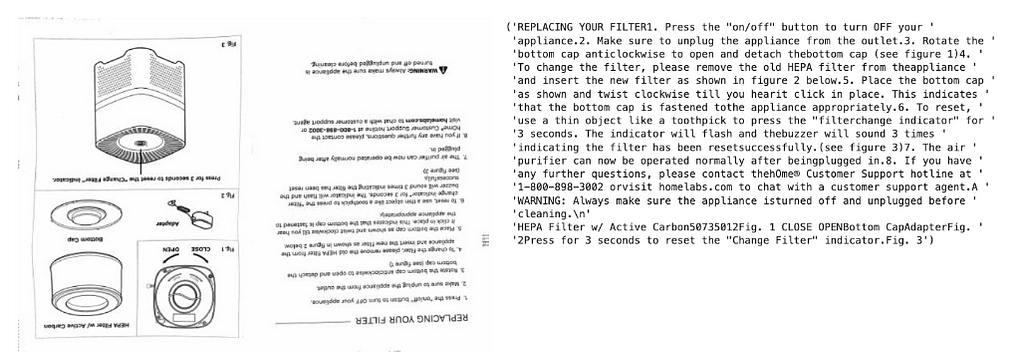
Now let’s use Langchain to prompt gpt-4-vision to extract some information from our receipts. We can start by using Langchain’s support for Pydantic to create a model for the output.
from langchain_core.pydantic_v1 import BaseModel, Field
from typing import List
class ReceiptItem(BaseModel):
"""Information about a single item on a reciept"""
item_name: str = Field("The name of the purchased item")
item_cost: str = Field("The cost of the item")
class ReceiptInformation(BaseModel):
"""Information extracted from a receipt"""
vendor_name: str = Field(
description="The name of the company who issued the reciept"
)
vendor_address: str = Field(
description="The street address of the company who issued the reciept"
)
datetime: str = Field(
description="The date and time that the receipt was printed in MM/DD/YY HH:MM format"
)
items_purchased: List[ReceiptItem] = Field(description="List of purchased items")
subtotal: str = Field(description="The total cost before tax was applied")
tax_rate: str = Field(description="The tax rate applied")
total_after_tax: str = Field(description="The total cost after tax")
This is very powerful because Langchain can use this Pydantic model to construct format instructions for the LLM, which can be included in the prompt to force it to produce a json output with the specified fields. Adding new fields is as straightforward as just updating the model class.
Next, let’s build the prompt, which will just be static:
from dataclasses import dataclass
@dataclass
class VisionReceiptExtractionPrompt:
template: str = """
You are an expert at information extraction from images of receipts.
Given this of a receipt, extract the following information:
- The name and address of the vendor
- The names and costs of each of the items that were purchased
- The date and time that the receipt was issued. This must be formatted like 'MM/DD/YY HH:MM'
- The subtotal (i.e. the total cost before tax)
- The tax rate
- The total cost after tax
Do not guess. If some information is missing just return "N/A" in the relevant field.
If you determine that the image is not of a receipt, just set all the fields in the formatting instructions to "N/A".
You must obey the output format under all circumstances. Please follow the formatting instructions exactly.
Do not return any additional comments or explanation.
"""
Now, we need to build a class that will take in an image and send it to the LLM along with the prompt and format instructions.
from langchain.chains import TransformChain
from langchain_core.messages import HumanMessage
from langchain_core.runnables import chain
from langchain_core.output_parsers import JsonOutputParser
import base64
from langchain.callbacks import get_openai_callback
class VisionReceiptExtractionChain:
def __init__(self, llm):
self.llm = llm
self.chain = self.set_up_chain()
@staticmethod
def load_image(path: dict) -> dict:
"""Load image and encode it as base64."""
def encode_image(path):
with open(path, "rb") as image_file:
return base64.b64encode(image_file.read()).decode("utf-8")
image_base64 = encode_image(path["image_path"])
return {"image": image_base64}
def set_up_chain(self):
extraction_model = self.llm
prompt = VisionReceiptExtractionPrompt()
parser = JsonOutputParser(pydantic_object=ReceiptInformation)
load_image_chain = TransformChain(
input_variables=["image_path"],
output_variables=["image"],
transform=self.load_image,
)
# build custom chain that includes an image
@chain
def receipt_model_chain(inputs: dict) -> dict:
"""Invoke model"""
msg = extraction_model.invoke(
[
HumanMessage(
content=[
{"type": "text", "text": prompt.template},
{"type": "text", "text": parser.get_format_instructions()},
{
"type": "image_url",
"image_url": {
"url": f"data:image/jpeg;base64,{inputs['image']}"
},
},
]
)
]
)
return msg.content
return load_image_chain | receipt_model_chain | JsonOutputParser()
def run_and_count_tokens(self, input_dict: dict):
with get_openai_callback() as cb:
result = self.chain.invoke(input_dict)
return result, cb
The main method to understand here is set_up_chain , which we will walk through step by step. These steps were inspired by this blog post.
Note that we’re also making use of openai callbacks to count the tokens and spend associated with each call.
To run this, we can do the following:
from langchain_openai import ChatOpenAI
from tempfile import NamedTemporaryFile
model = ChatOpenAI(
api_key={your open_ai api key},
temperature=0, model="gpt-4-vision-preview",
max_tokens=1024
)
extractor = VisionReceiptExtractionChain(model)
# image from PDFBytesToImage.convert_bytes_to_jpeg()
prepared_data = {
"image": image
}
with NamedTemporaryFile(suffix=".jpeg") as temp_file:
prepared_data["image"].save(temp_file.name)
res, cb = extractor.run_and_count_tokens(
{"image_path": temp_file.name}
)
Given our random document above, the result looks like this:
{'vendor_name': 'N/A',
'vendor_address': 'N/A',
'datetime': 'N/A',
'items_purchased': [],
'subtotal': 'N/A',
'tax_rate': 'N/A',
'total_after_tax': 'N/A'}
Not too exciting, but at least its structured in the correct way! When a valid receipt is provided, these fields are filled out and my assessment from running a few tests on different receipts it that its very accurate.
Our callbacks look like this:
Tokens Used: 1170
Prompt Tokens: 1104
Completion Tokens: 66
Successful Requests: 1
Total Cost (USD): $0.01302
This is essential for tracking costs, which can quickly grow during testing of a model like gpt-4.
Let’s assume that we’ve used the steps in part 4 to generate some examples and saved them as a json file. Each example consists of some extracted text and corresponding key information as defined by our ReceiptInformation Pydantic model. Now, we want to inject these examples into a call to gpt-3.5-turbo, in the hope that it can generalize what it learns from them to a new receipt. Few-shot learning is a powerful tool in prompt engineering and, if it works, would be great for this use case because whenever a new format of receipt is detected we can generate one example using gpt-4-vision and append it to the list of examples used to prompt gpt-3.5-turbo. Then when a similarly formatted receipt comes along, gpt-3.5-turbo can be used to extract its content. In a way this is like template matching, but without the need to manually define the template.
There are many ways to encourage text based LLMs to extract structured information from a block of text. One of the newest and most powerful that I’ve found is here in the Langchain documentation. The idea is to create a prompt that contains a placeholder for some examples, then inject the examples into the prompt as if they were being returned by some function that the LLM had called. This is done with the model.with_structured_output() functionality, which you can read about here. Note that this is currently in beta and so might change!
Let’s look at the code to see how this is achieved. We’ll first write the prompt.
from langchain_core.prompts import ChatPromptTemplate, MessagesPlaceholder
@dataclass
class TextReceiptExtractionPrompt:
system: str = """
You are an expert at information extraction from images of receipts.
Given this of a receipt, extract the following information:
- The name and address of the vendor
- The names and costs of each of the items that were purchased
- The date and time that the receipt was issued. This must be formatted like 'MM/DD/YY HH:MM'
- The subtotal (i.e. the total cost before tax)
- The tax rate
- The total cost after tax
Do not guess. If some information is missing just return "N/A" in the relevant field.
If you determine that the image is not of a receipt, just set all the fields in the formatting instructions to "N/A".
You must obey the output format under all circumstances. Please follow the formatting instructions exactly.
Do not return any additional comments or explanation.
"""
prompt: ChatPromptTemplate = ChatPromptTemplate.from_messages(
[
(
"system",
system,
),
MessagesPlaceholder("examples"),
("human", "{input}"),
]
)
The prompt text is exactly the same as it was in section 4, only we now have a MessagesPlaceholder to hold the examples that we’re going to insert.
class Example(TypedDict):
"""A representation of an example consisting of text input and expected tool calls.
For extraction, the tool calls are represented as instances of pydantic model.
"""
input: str
tool_calls: List[BaseModel]
class TextReceiptExtractionChain:
def __init__(self, llm, examples: List):
self.llm = llm
self.raw_examples = examples
self.prompt = TextReceiptExtractionPrompt()
self.chain, self.examples = self.set_up_chain()
@staticmethod
def tool_example_to_messages(example: Example) -> List[BaseMessage]:
"""Convert an example into a list of messages that can be fed into an LLM.
This code is an adapter that converts our example to a list of messages
that can be fed into a chat model.
The list of messages per example corresponds to:
1) HumanMessage: contains the content from which content should be extracted.
2) AIMessage: contains the extracted information from the model
3) ToolMessage: contains confirmation to the model that the model requested a tool correctly.
The ToolMessage is required because some of the chat models are hyper-optimized for agents
rather than for an extraction use case.
"""
messages: List[BaseMessage] = [HumanMessage(content=example["input"])]
openai_tool_calls = []
for tool_call in example["tool_calls"]:
openai_tool_calls.append(
{
"id": str(uuid.uuid4()),
"type": "function",
"function": {
# The name of the function right now corresponds
# to the name of the pydantic model
# This is implicit in the API right now,
# and will be improved over time.
"name": tool_call.__class__.__name__,
"arguments": tool_call.json(),
},
}
)
messages.append(
AIMessage(content="", additional_kwargs={"tool_calls": openai_tool_calls})
)
tool_outputs = example.get("tool_outputs") or [
"You have correctly called this tool."
] * len(openai_tool_calls)
for output, tool_call in zip(tool_outputs, openai_tool_calls):
messages.append(ToolMessage(content=output, tool_call_id=tool_call["id"]))
return messages
def set_up_examples(self):
examples = [
(
example["input"],
ReceiptInformation(
vendor_name=example["output"]["vendor_name"],
vendor_address=example["output"]["vendor_address"],
datetime=example["output"]["datetime"],
items_purchased=[
ReceiptItem(
item_name=example["output"]["items_purchased"][i][
"item_name"
],
item_cost=example["output"]["items_purchased"][i][
"item_cost"
],
)
for i in range(len(example["output"]["items_purchased"]))
],
subtotal=example["output"]["subtotal"],
tax_rate=example["output"]["tax_rate"],
total_after_tax=example["output"]["total_after_tax"],
),
)
for example in self.raw_examples
]
messages = []
for text, tool_call in examples:
messages.extend(
self.tool_example_to_messages(
{"input": text, "tool_calls": [tool_call]}
)
)
return messages
def set_up_chain(self):
extraction_model = self.llm
prompt = self.prompt.prompt
examples = self.set_up_examples()
runnable = prompt | extraction_model.with_structured_output(
schema=ReceiptInformation,
method="function_calling",
include_raw=False,
)
return runnable, examples
def run_and_count_tokens(self, input_dict: dict):
# inject the examples here
input_dict["examples"] = self.examples
with get_openai_callback() as cb:
result = self.chain.invoke(input_dict)
return result, cb
TextReceiptExtractionChain is going to take in a list of examples, each of which has input and output keys (note how these are used in the set_up_examples method). For each example, we will make a ReceiptInformation object. Then we format the result into a list of messages that can be passed into the prompt. All the work in tool_examples_to_messages is there just to convert between different Langchain formats.
Running this looks very similar to what we did with the vision model:
# Load the examples
EXAMPLES_PATH = "receiptchat/datasets/example_extractions.json"
with open(EXAMPLES_PATH) as f:
loaded_examples = json.load(f)
loaded_examples = [
{"input": x["file_details"]["extracted_text"], "output": x}
for x in loaded_examples
]
# Set up the LLM caller
llm = ChatOpenAI(
api_key=secrets["OPENAI_API_KEY"],
temperature=0,
model="gpt-3.5-turbo"
)
extractor = TextReceiptExtractionChain(llm, loaded_examples)
# convert a PDF file form Google Drive into text
text = PDFBytesToImage.convert_bytes_to_text(downloaded_data)
extracted_information, cb = extractor.run_and_count_tokens(
{"input": text}
)
Even with 10 examples, this call is less than half the cost of the gpt-4-vision and also alot faster to return. As more examples get added, you may need to use gpt-3.5-turbo-16k to avoid exceeding the context window.
Having collected some receipts, you can run the extraction methods described in sections 4 and 5 and collect the result in a dataframe. This then gets stored and can be appended to whenever a new receipt appears in the Google Drive.

Once my database of extracted receipt information grows a bit larger, I plan to explore LLM-based question answering on top of it, so look out for that article soon! I’m also curious about exploring a more formal evaluation method for this project and comparing the results to what can be obtained via AWS Textract or similar products.
Thanks for making it to the end! Please feel free to explore the full codebase here https://github.com/rmartinshort/receiptchat. Any suggestions for improvement or extensions to the functionality would be much appreciated!
How to Build a Generative AI Tool for Information Extraction from Receipts was originally published in Towards Data Science on Medium, where people are continuing the conversation by highlighting and responding to this story.
Originally appeared here:
How to Build a Generative AI Tool for Information Extraction from Receipts

It’s not a secret that many vacancies in IT & data are remote. On one hand, this means not wasting time in traffic jams on the way to work and back home. But on the other hand, for many employees the office atmosphere allows them to get organized and be ready for productive work.
Below I will share with you a few practical recipes that help remote employees to feel themselves more inclusive in a team. They are 100% based on my very own experience of working remotely as Data Analyst & IT specialist for 2.5+ years.

While being a remote worker, try to create a structured daily schedule that includes work hours, break for lunch, and time for social interactions. This can help you stay productive and maintain a sense of doing your job by design in a thorough manner.
Start your day with the activities that motivate you the most — for me these are intensive tasks like working on the most important projects or starting new ones from scratch. Besides that, I also try to include in my ‘before-afternoon-routine’ at least one unpleasant small task (a.k.a a frog) that doesn’t eat too much time, but requires your involvement.
By the way, you might read about examples of such frogs in one of my previous posts [1].
But don’t panic when something unexpected happens (i.e. something out of your routine) — for instance, you get an immediate request to connect with clients right now or one of your colleagues suddenly falls ill. Trust me, it’s not an extraordinary case at all, especially for long-lasting and complex projects. In such situations, try to solve these issues and then get back to your normal daily routine without outliers as soon as possible.

Communication is a key skill for any data-related (and not only) team, but it becomes a must for remote collective. Make a habit to regularly communicate with your colleagues via work chats or using video calls. This can help you feel connected to your team and reduce feelings of isolation.
One of the company where I worked had a good tradition of holding virtual Monday meetings, during which we share not only professional updates about the projects we are working on, but also some personal issues, e.g. how we spent the weekend or recommendations on what films to watch or what museums and concerts to go to.
Also, we try to have considerable amount of regular common activities after work, e.g. strategical sessions, town halls (every second week), or just quizzes. This helps to learn more about your team (their tastes and preferences), as well as to maintain team spirit (the latter significantly ease the common work with people who work from different parts of the world on challenging projects).

In addition to a lunch break, don’t forget to schedule regular breaks throughout your day to step away from your work and recharge. Use this time to go for a walk (at least to your closest window), do some stretching exercises, or engage in a hobby to split up the monotony of remote work.
Ability to turn off your brain for a short period of time during such a 5-min breaks will allow you to avoid burnouts and return to the current task with fresh mind (for some data-related tasks this can be a game changer). Very often this approach allows me to look at the challenging projects under a bit different angles and solve them more effectively.

This advice emphasizes the importance of having a bit extra space out of your work, although in a case of working remotely this might be quite tricky. Being loyal to your company is important, but don’t underestimate a creation of your own personal brand and reputation by joining similar groups of people.
Which communities to join? Well, this depends only on your taste. I recommend to consider both communities within your company (not necessary virtual ones!), as well as other groups of like-minded individuals, for instance those who are also working remotely or belong to IT sphere [2, 3]. Doing so will give you a sense of camaraderie and support, as well as opportunities for networking and socializing.

In general, establishing clear boundaries between work and personal life is crucial to maintain a healthy work-life balance. Create a designated workspace, set specific work hours, and make time for activities outside of work to avoid feeling isolated.
It’s not just about saying “No” when you really can’t afford another time-consuming project (trust me, it’s smarter than missing deadlines on an endless number of projects for which you “kindly” said “Yes”), but rather about a necessity to clear draw red lines which it is better not to go beyond to anyone from your team. For instance, not having any communication with colleagues during non-working hours / at night / during vacations. Doing so you will feel yourself much more relaxed and balanced, while helping others to respect your honesty and a sober look at your capabilities.
The effectiveness of remote work is vital for maximizing productivity and ensuring a healthy work-life balance. By following the advice of establishing a routine, communicating with colleagues effectively, setting up a dedicated workspace, taking breaks, and prioritizing self-care, we can create a conducive environment for remote work success. This is especially important for getting better conditions for those working in IT & data, where focus and concentration are essential for writing high-quality code.
By implementing above-mentioned strategies, IT specialists can optimize their workflow, enhance their problem-solving abilities, and ultimately produce better programming outcomes. Embracing the principles of remote work effectiveness is key to achieving success in today’s digital age.
I hope you found this short article useful. Thanks for reading, and please let me know if you have any questions/comments on the post’s content!
How to Work Remotely and Not Feel Isolated was originally published in Towards Data Science on Medium, where people are continuing the conversation by highlighting and responding to this story.
Originally appeared here:
How to Work Remotely and Not Feel Isolated
Go Here to Read this Fast! How to Work Remotely and Not Feel Isolated


Currently, I am a data scientist over 4 years of experience. I want to delve into my own journey — a gradual process of discovering my passion for data science. It took me quite a while to figure out my career path, but the journey was certainly worthwhile. I hope my story serves as inspiration to anyone out there who may be struggling to become a data scientist or doubting their own abilities.

“I work at a meth lab”. This was how poor my English was when I first moved to the States all by myself. I didn’t know there was a difference between “meth” and “math”. It took me about a year to finally grasp the distinction. I wasn’t involved in making drugs; instead, I was a math tutor at The Math Lab at City College of San Francisco (CCSF).
After failing the college entry exam in South Korea, I relocated myself to the United States, believing I can build a new life here. I was a bold and naive 18 years old girl. I vividly remember the first few days in downtown San Francisco, where I couldn’t even manage to order a simple cup of coffee at Starbucks. I stumbled over my words, leaving the employee perplexed, and she responded in rapid English. Feeling overwhelmed, I resorted to a bow of thanks, a gesture from Korean culture, before hastily leaving the store.
To improve my English skills, I enrolled in a community college. There, I explored various subjects, including German, Swimming, Computer Science, Math, English and Statistics. Amidst this exploration, I found my passion. My childhood dream was to become a math teacher, driven by my love for Mathematics and children. As I pursued relevant courses, I found that taking Statistics was a game-changer. I fell in love with every aspect of it, which ultimately led me to pursue a major in Statistics when transferring.

My parents never left South Korea, let alone attended a college. When I gained the admission to multiple universities, they were unfamiliar with prestigious institutions like UC Berkeley. Nonetheless, they were willing to support me financially, covering tuition and living expenses, proud in the knowledge that their daughter was embarking on a college education.
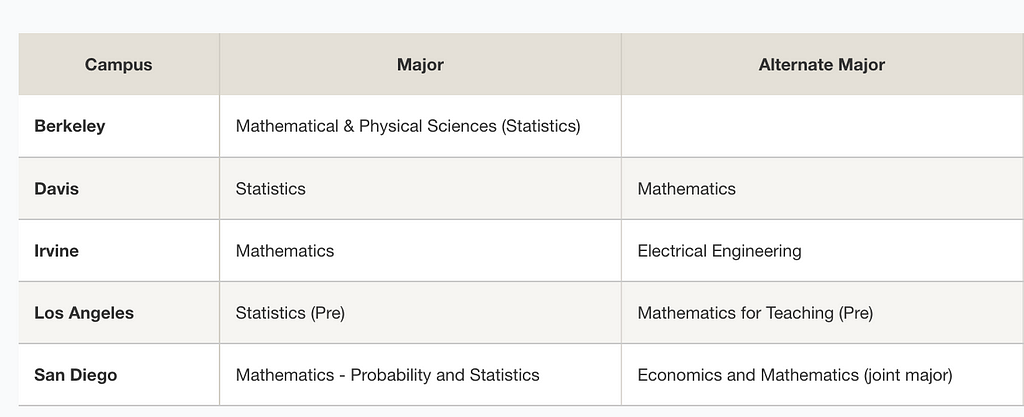
As a junior majoring Statistics at UC Berkeley, I explored potential career paths. I joined both Statistics club and Actuarial club to gain insights. Initially, becoming an actuary seemed like a logical choice — I enjoyed solving math problems, passed a few actuarial exams, and completed an actuarial internship. However, I encountered difficulties in securing a full-time actuarial position. Despite this setback, I now see it as a learning experience. Looking back, I realize that my current job brings me more satisfaction than I would have found in an actuarial role.


Upon graduating, I had two job offers: a data analytics internship at a startup and a merchandise planner position at an e-commerce company. I chose to become a merchandise planner and had the opportunity to collaborate with data scientists there. They were working on developing a machine learning model for demand forecasting and pricing, a topic I had throughly enjoyed studying during my time at UC Berkeley. Witnessing the practical application of machine learning in business was incredibly rewarding. Seeking guidance, I turned to a data scientist I knew at the company. He advised me to pursue further education to become a data scientist, especially considering the visa challenges I faced as an international student.
I moved to Pittsburgh, PA to pursue my master’s degree at Carnegie Mellon University (CMU). Taking the Statistical Computing course with Professor Alex Reinhart enhanced my Python skills, while the Data Mining course from Professor Sivaraman Balakrishnan prepared me well for machine learning interviews. I went to their office hours almost every week and they were tremendously helpful. The quality education I received at CMU enabled me to leverage my coding skills, project experiences, and coursework knowledge to successfully navigate data science interviews.

It wasn’t easy. Over a span of 4–5 months, I applied to approximately 700 jobs, targeting junior data scientist positions. I didn’t know which company was hiring foreign employees, so I applied all. Despite the uncertainty, I received responses from over 20 companies and progressed to the final stages with 4 of them, all of which extended job offers.
It took considerable time and effort to reach this point, and the journey was challenging and unpredictable. Job hunting was fraught with setbacks and stress, but my belief in my abilities kept me going and ultimately led me to success in this field. I firmly believe that anyone equipped with the right skills and a positive mindset can forge a career in data science. I hope my story serves as inspiration to others!
How I Became a Data Scientist as an International Student with Broken English was originally published in Towards Data Science on Medium, where people are continuing the conversation by highlighting and responding to this story.
Originally appeared here:
How I Became a Data Scientist as an International Student with Broken English


Originally appeared here:
Knowledge Bases for Amazon Bedrock now supports custom prompts for the RetrieveAndGenerate API and configuration of the maximum number of retrieved results


This sophistication matrix can show you where you need to go
Originally appeared here:
Does Your Company Have a Data Strategy?
Go Here to Read this Fast! Does Your Company Have a Data Strategy?


Elevating your RAG System: A step-by-step guide to advanced enhancements via LLM evaluation, with a real-world data use case
Originally appeared here:
Mastering RAG Systems: From Fundamentals to Advanced, with Strategic Component Evaluation